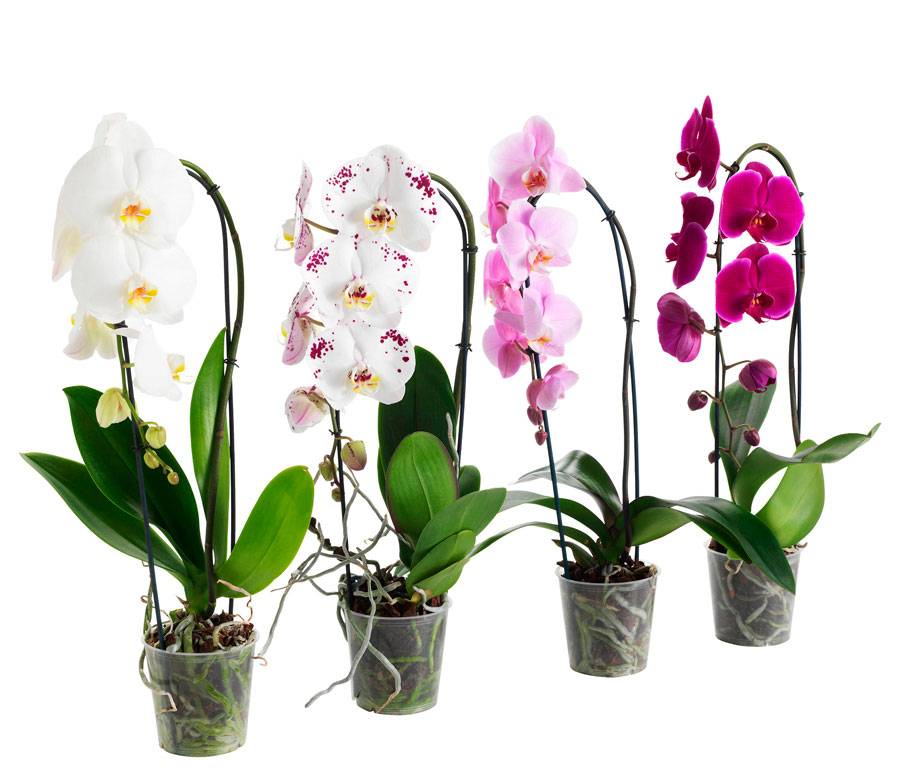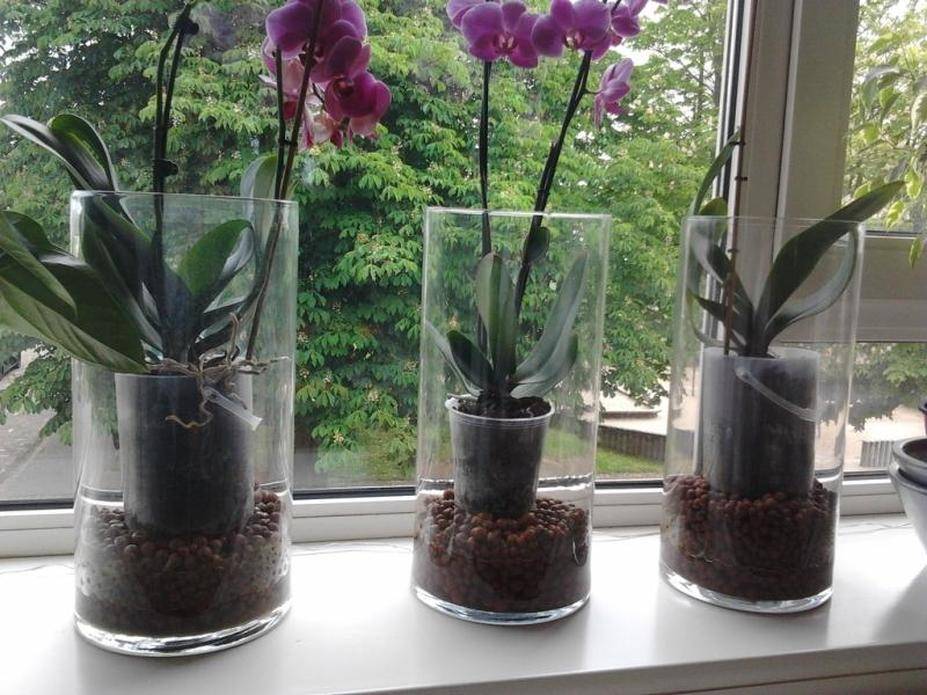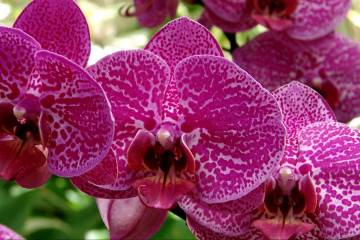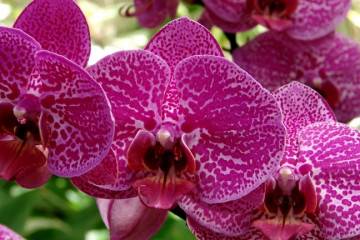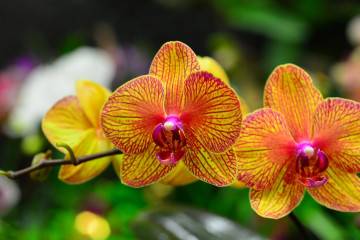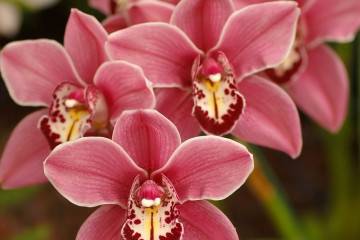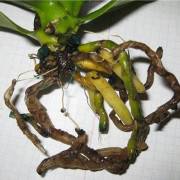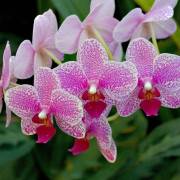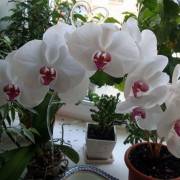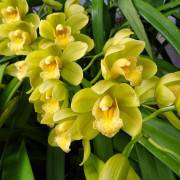Phalaenopsis orchid - home care
Content:
Phalaenopsis orchids are one of the most popular species that flower growers have chosen. The name Phalaenopsis in translation means "like a moth". And this is true, the shape of the flower resembles a butterfly.
Description of the phalaenopsis orchid
Phalaenopsis belongs to the Orchid family. In nature, this plant can be found in Asia, Australia and the Philippines.
The species differs from other plants by its unique data:
- flower height reaches 70 cm, with the exception of mini orchids;
- fleshy leaves, about 6 pcs. on a plant;
- the peduncle reaches 70 cm;
- aerial roots are green-gray in color.
Common varieties
Several varieties of phalaenopsis are popular among florists:
- Phalaenopsis is deer-horned. The height of this plant reaches 40 cm. About 12 buds appear on the peduncle. The green-yellow petals are covered with red spots, and the lip of the flower remains white;
- Phalaenopsis Stewart. Its difference lies not only in the variegated color of the petals, but also in the flowering period. The plant throws out its flowers in winter. Their color is creamy white with an orange-yellow lip. The flower diameter reaches 5 cm;
- Phalaenopsis Luddemann. The height of the peduncle reaches 30 cm, and the plant itself grows up to 20 cm.No more than 7 flowers appear on Luddeman. The variety has a delicate aroma. Petals from lilac-pink to burgundy;
- Phalaenopsis Golden beauty. Up to 3 peduncles bloom on it, each of which forms 15 buds. Delicate yellow flowers have a white spot at the very base.
In addition, other mini phalaenopsis are famous for their beauty, as well as the attractive burgundy-crimson Stone Rose orchid.
Features of home care
Florists often wonder how to care for phalaenopsis at home? Despite the increased exactingness of this flower, caring for it is not difficult at all. If you adhere to the recommendations of flower growers, then the plant will delight with its extraordinary beauty all year round.
Temperature
The temperature regime for an orchid is very important. It is on him that flowering depends. If in winter the plant stays in a room where the temperature is about 25 ° C, then the orchid will not bloom.
The optimum temperature is considered not lower than 16 ° С and not higher than 18 ° С in winter, and in summer it should fluctuate in the aisles of 20-25 ° С.
Lighting
Phalaenopsis flower thrives on both the east and west windows. The plant can be placed in the back of the room, but at the same time it needs to provide additional white fluorescent light or turn on a special phytolamp.
The flower also needs additional lighting in the autumn-winter period. The duration of daylight hours at this time should be at least 12 hours.
Watering
Phalaenopsis is watered in one of two ways:
- using a watering can. So it is better to water the orchid when it blooms, since during this period it is advisable not to change the location of the plant, otherwise it will drop flowers;
- by immersion. This method is used when the orchid is not blooming. The plant pot is immersed for 1 or 2 minutes. into a container with water. When the air bubbles cease to stand out, the pot is pulled out. The water should drain completely, and only then the orchid is returned to its place.
Water for irrigation is defended during the day. It should be no lower than room temperature, and preferably 4 ° higher. If there is a lot of lime in the water, it must be neutralized:
- water is poured into a plastic bottle and frozen. After that, the bottom of the bottle is cut off and the water is drained in parts;
- oxalic acid must be added to the water. For 1 liter, use acids at the tip of a knife. After that, the solution is allowed to stand for 2 or 4 days. When the settled salt is visible at the bottom, you can start watering.
Spraying
Caring for the phalaenopsis orchid at home involves regular spraying. The flower cannot stand dry air. This is especially true in the winter period, when the heating is turned on. At this time, the orchid is sprayed up to 5 times a day.
Humidity
In natural tropical conditions where orchids grow, air humidity reaches 90%, but in an apartment it will be enough to maintain it at 40-60%. This is especially important in winter, when the batteries dry the air up to 20%.
To maintain the humidity at the correct level, you must use any of the following methods:
- hang wet towels on the batteries;
- purchase a humidifier;
- put an aquarium with fish next to the flower;
- spray the plant regularly;
- install the pot in a pallet with expanded clay or moss.
Priming
The basis of the substrate for the phalaenopsis orchid is the bark of the small and medium fraction. If the air in the room is dry, then pieces of sphagnum moss should be added to the bark.
Basically, the bark of the middle fraction is spread on the bottom, and closer to the surface it is poured with a fine one.
Top dressing
Orchids are fertilized mainly during the flowering period. If the plant blooms in summer, it is fed 2-3 times a month, and during the autumn flowering period, it can also be 2-3 times, or 1-2. Fertilizers for this species will help restore vitality to bestow lush flowering. In the absence of flowers, top dressing can be omitted.
Features of winter care during the rest period
Phalaenopsis does not have a clearly defined dormant period, but the rules of care for this plant in winter should be changed.
As already mentioned, the orchid needs to provide additional lighting so that the duration of daylight hours is at least 12 hours. The room must adhere to a temperature regime of at least 16 ° C. Watering is required in moderation, only after the soil has completely dried out.
Pruning
Cutting the peduncle after flowering is not worth it. The plant decides for itself whether it will still throw out the buds or not. If the peduncle is completely dry, then it can be cut off.
When and how it blooms
If we are talking about a recently acquired plant, then you should not expect rapid flowering from it. He needs a period of adaptation, therefore, after the purchase, at least 3-4 months must pass.
Phalaenopsis mainly blooms 2 times a year, but very rarely there are exceptions when it throws flowers 3 times a year.
Phalaenopsis has a variety of colors. On it you can see flowers from white to burgundy. There are also blue specimens.
How phalaenopsis reproduces
The breeding process for an orchid is very simple. It happens with the help of:
- kids.They form on their own after flowering. However, if they do not appear for a long time, then their growth can be stimulated. To force the orchid to grow babies, you need to ensure small differences in day and night temperatures, and also stop watering for 2 weeks. Children cannot be separated from the mother plant until they have 2 leaves each and 5 cm roots appear;
- peduncle. After the phalaenopsis has faded, it is necessary to cut the peduncle and divide it into parts. Each piece should have a sleeping bud. All sections are treated with activated carbon. Then they are placed in a small greenhouse with sphagnum moss. In this case, the temperature regime should be at least 25 ° C.
Transfer
The orchid cannot be transplanted during the flowering period, since it will have to spend a lot of energy on flowering and rooting at the same time, and this can lead to serious consequences. It is best to transplant the plant immediately after flowering. This happens mainly in spring or autumn.
In order for the orchid to successfully grow and develop further, you must follow the step-by-step instructions for transplanting:
- First, the orchid must be removed from the pot. If the flower cannot be pulled out, you can crush the pot or cut it altogether.
- The roots need to be freed from the old bark, if any piece has grown to the flower, then this is not scary.
- It is imperative to eliminate decayed or dead roots, but at the same time it is better not to touch the healthy part.
- Dry the flower before planting. This process takes 2 hours on average.
- Phalaenopsis is planted in soil and not watered for 5 days. Also, the first month is not recommended to make feeding.
Diseases and pests
Orchids, like many flowers, are susceptible to a variety of diseases. Therefore, if you have to wonder why the plant loses its decorative appearance, it means that there is a possibility that the flower has caught one of the bacterial or fungal infections. The most common among them are:
- fusarium. If a plant is often flooded with water or planted in unsuitable soil for it, then it can suffer from this disease. Fusarium is not cured, therefore, after infection, you will have to throw out the pot;
- black rot. With this disease, the leaves of the orchid turn black like coal. The affected parts must be cut off, and the plant must be treated with fungicides. If you immediately begin to resuscitate a flower, then it can still be saved;
- botrix. With this disease, dark spots appear on the leaves. If you do not start treatment in time, orchid petals will also suffer. They will not only be covered with these spots, but will also begin to crumble.
In addition to diseases, phalaenopsis can be attacked by pests. The most common among them are spider mites, thrips, scale insects, aphids and mealybugs. They suck the sap from the plants, and their leaves begin to wilt and turn yellow. To prevent this from happening, you first need to wash off the pests with water, and then treat the orchid with insecticides. In the fight against parasites, Aktelik and Aktara have proven themselves well.
Phalaenopsis belongs to unpretentious flowers, and it is easy to care for it. If you reread all of the above about phalaenopsis, take care of it at home and do everything right, then the room will drown in the flowers of this unique plant.
